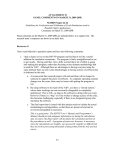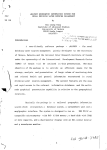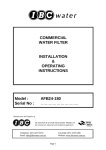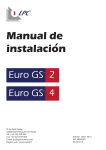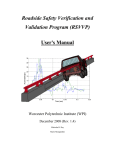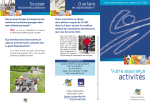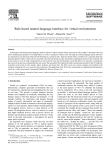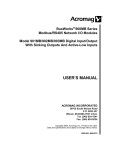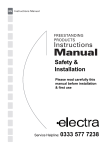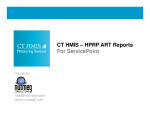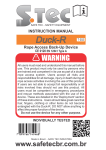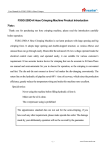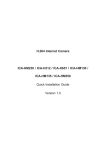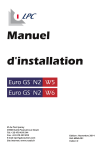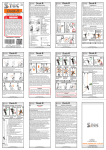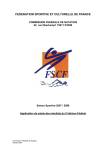Download Attachment B - Roadsafe LLC
Transcript
ATTACHMENT B NCHRP Project 22-24 Guidelines for Verification and Validation of Crash Simulations used in Roadside Safety Applications Comments on December 31, 2008 QPR Reviewer comments are in a regular face and the research team’s response in an italic font. Reviewer #1 1) Are the researchers going to complete the contract by Sept. 2009? Currently they have 63% complete with 9 months left in the contract? It will be difficult to complete by September especially without rushing the external reviewers. We have also fallen a little behind this past quarter. We would like to incorporate the V&V process for the new Silverado vehicle model being developed by the NCAC and the tractor-trailer model being developed by Battelle. Both of these efforts are not yet totally complete so we are experiencing a little delay due to that. The PI has also had conversations with several panel members about various additions, extensions and modifications to the project scope. The research team will be presenting an update of the project at the AFB20 summer meeting in San Antonio in late May. We believe that many of the panel members will be there. We would like to suggest that the research team and as many panel members as are present get together and discuss a schedule for finishing the project. One option would be a no-cost six month extension. Another, suggested by a panel member, is a year extension with objective of letting the user community use the procedure for a while and providing comments and suggestions. The team could then modify or adjust the procedures based on that more extensive review. In any case, these things probably need to be discussed in some depth with the panel. 2) I support and agree with the direction that the research team is headed. Thank you. 3) Nothing else sticks out worth commenting about in the QPR 7 or the attachments. Thank you. Reviewer #2 Attachment A Funds Expended should be 71.04 % instead of 104.04 %. You are absolutely correct. We apologize for the worksheet error; it has been corrected for future QPRs. B-1 Attachment B Task 8A Red and green symbols may be difficult for color blind people to see. One in every twelve men is red/green color blind. Could you put a dark border around the red symbol and a border made of dashed lines around the green symbol? That way, these symbols would still be visible when a black and white zerox copy is made of the sheet. This is not a major issue. It is one of those things that would be nice, but not absolutely necessary. This is no problem. We could probably do both – a dark solid red border around the unacceptable results and a lighter dashed green border around the acceptable results. Task 8B Line 35 after the heading, “900C Impacting a Rigid Concrete Wall” states, “The test report did not record the exit velocity and angle so they were scored as not agreeing, although an argument could be made that if the value was not reported, it should not be scored.” If the value is one of the required evaluation criteria in NCHRP 350 or EN1317 instead of an optional or “soft” criteria, then it should be scored even if the test value was not reported. It may be possible for the analyst to overcome this problem by reviewing the videotapes and/or high speed films of the test and determining the missing parameters. From a validation and verification standpoint, if key parameters, such as the lateral acceleration, have been omitted from the test report and their values cannot be established from the photographic coverage, then that particular test cannot be used for V&V purposes. Another test must be chosen. We agree. Attachments E and F The make of the car is not Peugeout 106, but Peugeot 106. Thank you, please excuse our French! MASH08 is expected to be MASH09 when it is released by AASHTO in September, 2009. True. When MASH finally does appear we will change everything in the final report and procedure documents to whatever is the agreed upon name. For now, however, we will continue to use MASHO8 just to avoid confusion. Page 4, the last line should read, “in an Appendix”. The same comment applies to page 6. Thank you, the correction has been made and the corrected copy will be reposted on the project website. USER’S MANUAL There should be some way to print out or document the input parameters and the options selected so that, if necessary, the computer run could be reproduced. Perhaps, on page B-2 28, the user should be instructed to create a folder called \input\ to document the input data stream. Another approach would be to have the software do this automatically. The following comments are primarily editorial. They are only for your consideration. You can use them or not, as you see fit. There is no need to respond to them individually. The Table of Contents on pages i and ii has the page numbers bracketed with minus signs, e.g. (-3-). This is unusual in this country. The authors should check with NCHRP and TRB to see if this meets their styling requirements for published documents. Page 1, line 12, “correct comparison” could be changed to “proper comparison”. There are many ways of comparing curves. There is no correct way of doing it. Page 1, line 17, “it simple compares” should be “it simply compares”. Page 6, line 12, the word “Preprocessing” begins with a capital letter. This type of capitalization frequently occurs throughout the text. It has some merit because it tends to call attention to the word and emphasize it. However, this may not meet NCHRP and TRB’s styling requirements for published documents. Page 7, last line, “defined filters parameters” should be “defined filter parameters”. Page 12, line 4, “asses” should be “assess”. Page 24, the title of Figure 17 should read in part, (b) the Minimum area Page 32, fourth line from the bottom should read, “ANOVA metrics are based on the assumption that two curves do, in fact, represent the same event so any differences between the curves” etc. References Reference no. 7. Is the word “Engng” the correct way of abbreviating the title of this publication, or should this word be spelled out? All the editorial comments shown above have been made to the User‟s Manual. Thank you for your careful reading. REVISED INTERIM REPORT Page 53, line 3. Dr. Vittorio Giavotto told us at the 2009 Annual TRB Meeting that the use of the PHD as an evaluation criteria was being discontinued in the next revision of EN 1317. If this change is actually made by the Europeans then perhaps it should be mentioned on this line. We agree. If they make the change before we finish the final report we will revise. B-3 The following comments are primarily editorial. They are only for your consideration. You can use them or not, as you see fit. There is no need to respond to them individually. Table of Contents, Chapter 2, Verification, Page 98. It states, “Two types of verification are discussed in this section”. It briefly describes one type of verification, but says nothing about the other type. This leaves the reader hanging. The Table of Contents is not the place to have a discussion about the various types of verification. A better statement would be as follows. “Two types of verification are discussed in this section, calculation verification and model assurance verification”. Table of Contents, List of Figures, This is the first time that I have seen reference numbers appended to the titles of figures. It’s all right with me if it is necessary to identify the source of the information shown in the figure. However, I recommend that you check with NCHRP and TRB to see if this meets with their editorial standards for documents that they will publish. The more conventional approach is to place sentences in the text that refer to, or describe, the figures and place reference numbers at the ends of these sentences. List of Tables. The above comment also applies to the reference numbers in the titles of tables. List of Figures, In the title for Figure 16, “debeading” should be “de-beading”. Same comment for this title which appears on page 62. List of Figures, The title for Figure 36 is incorrect. The crash test is on the left and the finite element analysis is on the right. This title should also be corrected on page 84. List of Tables, Table 5 should read, Metal components for the three simulation curves of Figure 10. List of Tables, Table 8 should read, pickup truck and the weak post guardrail. (Same comments for page 87). Check the name “WREAKER” on page 7. Accident investigators still use a crash code called WRECKER that was developed and supported by NHTSA. Page 8, the fourth line from the bottom should read, “was by Ray”. Page 8, the last line should read, “Histories obtained from nominally identical crash tests were not actually identical because they were subject to some random experimental variations.” Page 9, last line, designed based should be designs based. Page 10, line 2 should read, knowledge that forms the B-4 Page 12, line 2, are just one of many applications Page 18, line 11 should read, “like Report 350 and EN 1317 or successor documents”. Page 43, two words have changes in fonts imbedded in them. The words with stray italic fonts are on line 8, (t-statistic), and on line 11 (admissible). Page 45, under equation (34), v=n-1 degrees of freedom. Page 45, line 10 should read, The main idea of the Oberkampf and Barone metric was Page 48, line 16 should read, treat the inputs to Page 58, third line from the bottom should read, “cost as can be afforded”. Page 59, line 1 could read, “simulation. However, the model” The word “but” ties it to the pervious sentence which is already a very long sentence. Page 62, line 10 should read, “deflate the tire. Details of the load applicator” Page 70, in the second line from the bottom, EFigure 24 should be Figure 24. Page 75, line 8, performance of a thin-wall Page 77, line 24, “inertial affects” should be “inertial effects”. Page 87, fourth line from the bottom should read, “A validated model of the bogie vehicle (Bogie) and its honeycomb material” Not every reader will know what Bogie means. Page 94, 5th line from the bottom, “to have an 810 mm top rail height” Page 105, fourth line form the bottom, M-180 should stay together. Thank you for your careful review of the revised interim report. We have addressed all the comments you made above and have re-posted the revised interim report on the project website with the changes. Reviewer #3 1- Regarding the QPR the work overall. a. I think the work is heading in the right direction. Thank you. b. There should be some form of verification and validation process for the vehicle models. For example, we need to see good agreement with the B-5 NCAP tests if the vehicle model is going to be used for head on impacts (crash cushion, end terminals…etc). We need to have some suspension validation for impact cases where vehicular dynamics is critical to the outcome of the test. Basically, features that are incorporated in the vehicle models should be validated if they have a big consequences on the response (suspension, tires…etc). We agree. We have started working on a vehicle model development form. A draft of that form is included in this QPR. We are using the NCAC Silverado and the Battelle tractor-trailer models as a test case for our form and will present those results in the next QPR. We expect to have these examples worked out by the next QPR and for a presentation at the AFB20 summer meeting. c. We need to be very careful about the PIRT passing criteria or score as presented in page 7 of the QPR as . In this way there is a passing grade even if there are few no’s. The concern with such approach has to do with a scenario if there is a very critical PIRT being quantified as NO but it may very well affect the test outcome. Let us discuss two examples: I- If we have a validation sign support impact in which the test did not have windshield damage and the validation model did not have a windshield damage model. So, everything passes with a flying color. Consequently, the analysts/engineer uses the validated model for a changed sign support height. The simulation indicates some interaction between the sign and the windshield. However, since there was no windshield damage model, that behavior may get a NO score but everything else is pretty good on the scoring system. The modified model will be considered a pass. If we run a test of such system we could very well have a windshield damage that does not pass NCHRP or MASH evaluation criteria. II- Similarly, if we have a passing guardrail system (say G41S) with no wbeam damage. The subsequent modification includes a curb or something that would probably induce a rupture in the w-beam material. However the material was modeled without rupture in the w-beam material since the benchmark test did not have such phenomena. So, the PIRT score will give a pass (for just one NO) but we may potential have an issue with the system integrity. I think that a scoring system that gives weights to critical PIRT should be implemented instead of averaging. B-6 This is an excellent comment and reflects the kind of discussion we (i.e., the roadside computational mechanics community) should be having. What we included in the last QPR was a first try at an approach. It seems there are two competing objectives to balance: on the one hand, we want a procedure/method that gives us confidence when we extrapolate results as shown in the examples the reviewer provided. On the other hand, we do not want to be overly rigid and exclude models that are actually pretty good even if they aren‟t perfect. There are a couple approaches and we would be interested in the panel‟s feedback on them. One is to simply require a “yes” response for all elements of the PIRT; this would be easy to implement but might be considered to “rigid” by the analysts. The other approach would be to assign a weight to each component of the PIRT. This would be a little tricky because the weights would depend on the particular test (i.e., the weights for a small car sign support test would be much different than a guardrail redirectional test with a pickup )and the weights would have to be applicable generally to all crashes at those conditions. Also, weights might depend a bit on the appurtenance struck in the same test (i.e., are the same things important in a test 3-11 of a concrete safety shape and a cable barrier?). We would like this to be the focus of our discussion with the panel and computational mechanics subcommittee at the summer meeting. Perhaps we can get the group to help determine some preliminary weights. 2- Regarding the QPR examples (attachment F and E) a. The examples are very useful in illustrating the process. Thank you. We were interested in stimulating some discussion like the one you bring up in your first comment as much as anything else. It is easier to do when looking at specifics. 3- RSVVP version 1.4 comments: a. The program is functional, stable and performs what it is supposed to do (signal to signal evaluation according to a set criterion or criteria). Thanks. b. The dialogue window (or widget) seems to be always “taller” than the monitor screen (even on different machines). The user has to move the program window (up or down) to see the whole area of it. We are aware of some annoying visualization problems related to the graphical user interfaces (GUIs) when running RSVVP under Windows Vista or on screens with a low resolution. Unfortunately, these problems seem to be out of our control as Matlab automatically compiles the source code into the executable. We will try to find a solution in the next release of RSVVP. B-7 c. It is a good write results to a separate folder other than “Results”. For example (results_01 ..etc) or prompt the user to specify folder name. We agree, this will allow the user to keep track of all the previous runs. The sequence numbering of the „Results‟ folder for each separate run of the RSVVP will be implemented in the next release of the program. d. It is better to remove the compression (.zip) since the user will uncompress first to view the data or incorporate them into some other documentation and/or presentation files. The average size of these files is not terribly big. The user will be given the option to compress/not compress the bitmap images in the next release of the RSVVP. Although the average dimension of the „Results‟ folder for a single run of the RSVVP is not excessively large, considering that the user may want to keep a copy of this folder for several runs during the initial stage of the Verification and Validation of a model, the size could increase dramatically. e. The suggested pass or fail (green or red squares) indicators are not conveyed/written to the excel sheet (Comparison Metrics). I think it is a good idea to add the “pass” and “fail” wording into say column C next to the metric value. Indeed, the idea of adding a Pass/Fail indicator also in the Excel spreadsheet will dramatically improve the readability of the results. Due to technical problems, it has not been implemented yet. Probably it will be in the next release of RSVVP. f. It is a good idea if the program keeps an “input file” of what the user entered. In this way, the input file can be read by RSVVP and the user can make some changes. In the coming release of RSVPP the user can now save a configuration file containing most of the options/information input/selected. Please, see the answer already given above for a similar comment posted by Reviewer# 2 g. I tested the program using made up signals. One of them is half-size wave versus a randomize (30% +/-) half sine wave signal as shown in Figure 1 below. The other test is for half sine wave versus a half sine wave with 30% lower response. I believe the assessment from the RSVVP make sense to me in terms of magnitude and phase qualifier. Thanks. We have tried a few analytical wave forms ourselves and seem to get reasonable results. B-8








